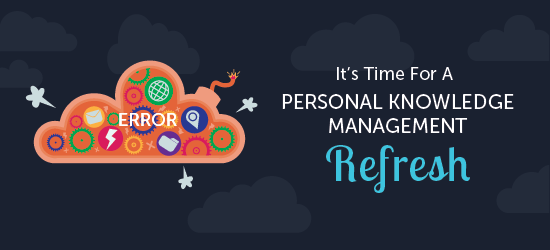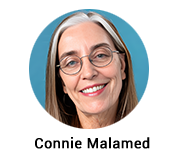
In the book, The End of Patience, author David Shenk distinguishes between information and knowledge.
“We must not confuse the thrill of acquiring or distributing information quickly with the more daunting task of converting it into knowledge and wisdom. Regardless of how advanced our computers become, we should never use them as a substitute for our own basic cognitive skills of awareness, perception, reasoning and judgment.”
I think Shenk’s sentiments are important to remember as we navigate a digital world of rich information and noisy misinformation. Our ability to analyze and interpret resources and assets are as important as finding them. Furthermore, the ability to transform information into knowledge would seem to be a critical skill for the 21st century learning professional.
As such, we may need to regularly update and refresh the strategies and tools we use for personal knowledge management (PKM). Below you will find some approaches and resources for managing the information flow in your world. Perhaps you can share your favorite strategies at the end in the Comments section.
1. Know Your Purpose
Your intent is an important consideration in personal knowledge management. Consider your purpose and let that influence your strategies.
- Are you seeking resources for professional development?
- Are you seeking information to keep up-to-date?
- Do you want to reflect more deeply about topics of interest?
- Are you trying to educate others at work?
- Are you making connections and building relationships?
- Do you want to contribute to a field of knowledge by sharing valuable resources?
- Do you want to join or build a community with common interests?
- Are you gathering information for a presentation, article or paper?
2. Define Your Boundaries
Not everyone wants to limit the information they ingest, but this strategy is valuable for those who feel overwhelmed. Rather than click on every link or skim every article that comes your way, define ahead of time what would be most helpful to learn in a particular timeframe. Or identify a few topics that have piqued your curiosity.
Then pursue a limited circle of interest and temporarily ignore information that is outside of your defined boundary. This could be done on a monthly basis. Intentional limitations might be frustrating for some but liberating for others.
3. Search and Find
It you are a proactive information seeker, search and find is your first mission. In addition to asking questions of those in your Personal Learning Network, you may find your best results when you look beyond your default search engine. For example, there are specialty search engines, social media searching, curated sites, videos, MOOCs, blogs, online magazines and social bookmark sites. See below for a few tool ideas.
Some Search Tools and Content Resources
- Search Engines: DuckDuckGo: (less cluttered, more privacy), Library of Congress, Google Scholar, WolframAlpha
- Specialty Search Engines: iSeek (education), Scienceresearch.com, Google Scholar (academic journals and articles), Social Science Research Network
- Social Media: Advanced Twitter Search, Twitter Lists, Social Mention
- MOOCs: Coursera, EdX, MIT Open Courseware, Stanford Online
- Video Presentations: Ted Talks, Google Talks, Big Think
- Podcasts: Apple Podcasts, Stitcher, Spotify
- Aggregators: Feedly, NetVibes
4. Evaluate and Filter
What is missing from search results is the human element that judges the validity and value of each resource. Fortunately, we can assess and interpret information to discern the signal from the noise. I will often find an article or video that seems worthy of sharing but as I read or listen to it, I see it is mostly fluff with less value than I originally thought. Some things to evaluate:
- Credibility of the information
- Trust you have in the source
- Value and benefit to yourself and others
- Unique or interesting perspective
- Time it takes for the resource to get to the point (suggested by Dana Hall)
I’m sure you can add to this list of filters you use. Please do so in the Comments below.
5. Capture and Organize
When content and resources pass your evaluation test, what do you do with your valuable assets? There are so many options, depending on your purpose. You can reflect on it, share it, find ways to make it more meaningful (see Share-Use below) or store it for future use.
We are fortunate to have many clip-the-web, read-later and annotation tools for future sharing. Having a good organization system is crucial for future search and retrieval. Good organization involves coming up with a structure that is meaningful to you and supplementing with categories, tags, annotations and notes. See the tools below for some of this functionality.
Some Capture and Organize Tools
Social Bookmarking: Pinterest, Diigo, Delicious
6. Share and Use
Personal knowledge management is dynamic. It invites us to connect, share and exchange. It also facilitates research, writing and creating. There are so many options, depending on your original purpose.
Some Tools for Share and Use
- Social Media: Twitter, Facebook, LinkedIn, Instagram, etc.
- Writing: WordPress (your own site), WordPress (hosted), Tumblr, Medium, SlideShare
- Curation: Storify, Scoop.it, List.ly, Zeef
- Information Graphics: Piktochart, Easeley, Venngage
- MindMaps: XMind, MindNode, Wisemapping
Have you refreshed and organized your PKM strategies lately? Share your tips below.

Thanks for your honest assessment. I’m sure many people feel like you, Maria.
Connie
Thanks for the advice. I find it really sensible and useful. I’ve just started to change my way of working trying to integrate technology in my teaching practice. I feel lost, unable sometimes.I need to follow guidelines in my proccess and this is a good start. Thank you, Connie
Hi Tim,
I know what you mean. After awhile, you can get into that addictive curiosity loop where you just start searching and reading and searching and reading and the next thing you know, an hour has passed and you never achieved your goal! Good to hear from you.
Connie
Hi Dana,
I love your Evaluate and Filter suggestion and I will add it to the list with you as a source. When you think about it, that’s really how we were taught to write in English class, right?
Best,
Connie
I would add to the ‘Evaluate and Filter’ list: time it takes for the resource to get to the point. So often I’m reading articles that have mostly fluff in the beginning and middle, and when when they finally do make their point, I realize the information wasn’t helpful, or at least not what I was looking for. The resources I prefer to use regularly make their ultimate point up front then provide a clear expectation of what I’ll discover if I keep reading. I don’t feel like I’m being dragged along for the ride. I’m given the information in the beginning to decide if this is an article I want to keep reading, essentially letting me decide for myself if I want or need to keep going. It opens the door to discover it myself. Exactly like your blog actually.
This is some great advice, Connie! Thanks for sharing. I particularly like the questions you have developed for the first step, Knowing Your Purpose in personal knowledge management. I think we set out with a particular strategy in mind, but it’s easy to get sidetracked and forget the main purpose we are trying to achieve.
Thanks
Tim
Nice! Thanks for sharing, Joe. Good to hear from you. Hope all is well.
Connie
Great tips, Connie! Thanks!
I find myself applying several of these, and have intentionally focused on improving some relevant skills, such as tactical search competency (filter early and often, and let the tools do your first triage), organizing by priority (some things I know I’ll never get to unless I really have to do deep dive, but I’ll drop bookmarks to resources into a “tentative” subfolder when appropriate), and follow-thru (I intentionally set aside time to go back to found resources, and I discard those which are certain to be neglected in the future).